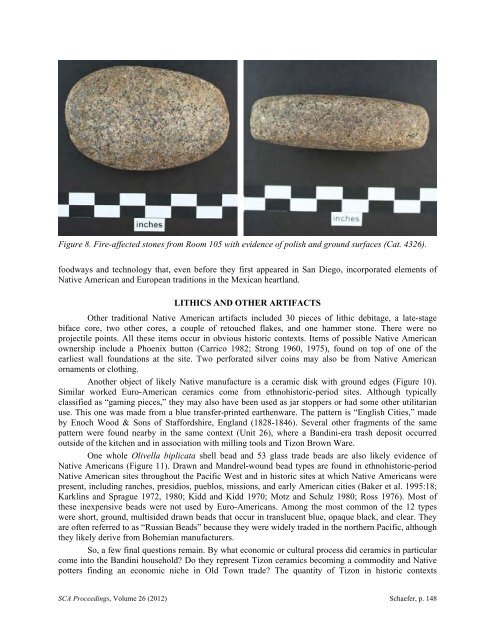Jerry Schaefer - Society for California Archaeology
Jerry Schaefer - Society for California Archaeology
Jerry Schaefer - Society for California Archaeology
Create successful ePaper yourself
Turn your PDF publications into a flip-book with our unique Google optimized e-Paper software.
Figure 8. Fire-affected stones from Room 105 with evidence of polish and ground surfaces (Cat. 4326).<br />
foodways and technology that, even be<strong>for</strong>e they first appeared in San Diego, incorporated elements of<br />
Native American and European traditions in the Mexican heartland.<br />
LITHICS AND OTHER ARTIFACTS<br />
Other traditional Native American artifacts included 30 pieces of lithic debitage, a late-stage<br />
biface core, two other cores, a couple of retouched flakes, and one hammer stone. There were no<br />
projectile points. All these items occur in obvious historic contexts. Items of possible Native American<br />
ownership include a Phoenix button (Carrico 1982; Strong 1960, 1975), found on top of one of the<br />
earliest wall foundations at the site. Two per<strong>for</strong>ated silver coins may also be from Native American<br />
ornaments or clothing.<br />
Another object of likely Native manufacture is a ceramic disk with ground edges (Figure 10).<br />
Similar worked Euro-American ceramics come from ethnohistoric-period sites. Although typically<br />
classified as “gaming pieces,” they may also have been used as jar stoppers or had some other utilitarian<br />
use. This one was made from a blue transfer-printed earthenware. The pattern is “English Cities,” made<br />
by Enoch Wood & Sons of Staf<strong>for</strong>dshire, England (1828-1846). Several other fragments of the same<br />
pattern were found nearby in the same context (Unit 26), where a Bandini-era trash deposit occurred<br />
outside of the kitchen and in association with milling tools and Tizon Brown Ware.<br />
One whole Olivella biplicata shell bead and 53 glass trade beads are also likely evidence of<br />
Native Americans (Figure 11). Drawn and Mandrel-wound bead types are found in ethnohistoric-period<br />
Native American sites throughout the Pacific West and in historic sites at which Native Americans were<br />
present, including ranches, presidios, pueblos, missions, and early American cities (Baker et al. 1995:18;<br />
Karklins and Sprague 1972, 1980; Kidd and Kidd 1970; Motz and Schulz 1980; Ross 1976). Most of<br />
these inexpensive beads were not used by Euro-Americans. Among the most common of the 12 types<br />
were short, ground, multisided drawn beads that occur in translucent blue, opaque black, and clear. They<br />
are often referred to as “Russian Beads” because they were widely traded in the northern Pacific, although<br />
they likely derive from Bohemian manufacturers.<br />
So, a few final questions remain. By what economic or cultural process did ceramics in particular<br />
come into the Bandini household? Do they represent Tizon ceramics becoming a commodity and Native<br />
potters finding an economic niche in Old Town trade? The quantity of Tizon in historic contexts<br />
SCA Proceedings, Volume 26 (2012) <strong>Schaefer</strong>, p. 148
















